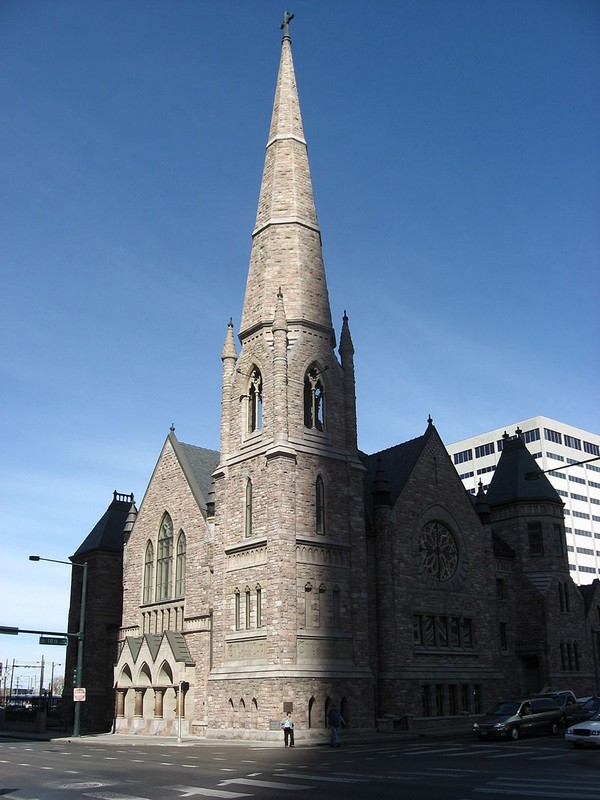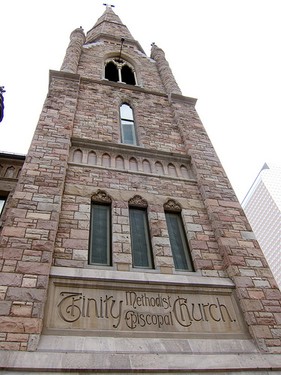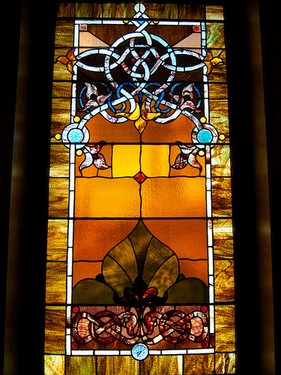Trinity United Methodist Church
Introduction
Text-to-speech Audio
Images
Trinity United Methodist Church, completed in 1888, stands at the corner of 18th Avenue and Broadway.

A polished cornerstone contrasts with the Castle Rock rhyolite of the exterior. Photo by beautifulcataya licensed under Creative Commons: https://creativecommons.org/licenses/by-nc-nd/2.0/legalcode

The church's steeple features a number of variation on the theme of threes, symbolizing the Holy Trinity. Photo by beautifulcataya licensed under Creative Commons: https://creativecommons.org/licenses/by-nc-nd/2.0/legalcode

The church's sanctuary is dominated by the massive Roosevelt organ. Photo by beautifulcataya licensed under Creative Commons: https://creativecommons.org/licenses/by-nc-nd/2.0/legalcode

Stained glass window in the Arts and Crafts style. Photo by beautifulcataya licensed under Creative Commons: https://creativecommons.org/licenses/by-nc-nd/2.0/legalcode

Stained glass window in the Arts and Crafs style. Photo by beautifulcataya licensed under Creative Commons: https://creativecommons.org/licenses/by-nc-nd/2.0/legalcode

Backstory and Context
Text-to-speech Audio
Trinity United Methodist Church had its beginnings in the first wave of Methodist Episcopal missionary activity in the new settlements created by the Pike’s Peak Gold Rush of 1858—1861. Founded in 1859 as the Auraria and Denver City Methodist Episcopal Mission, the church was incorporated in 1863 as the First Methodist Episcopal Church. Its congregants included many of the most prominent citizens of Denver, including Governor John Evans, who contributed to the building fund for the church’s first permanent home, at Lawrence and 14th Streets, a block away from what is now Larimer Square.
The rapid growth of the new city saw the original church’s neighborhood become crowded and commercial. Many former congregants preferred to attend churches in their new suburban neighborhoods. In the 1880s, the decision was made to move the church to a new location at 18th and Broadway. The new property stood at the eastern edge of the central business district, near the tree-lined streets and substantial homes of Capitol Hill. Within a few years, the church was joined by the Central Presbyterian Church, two blocks away at 17th and Sherman. By the early years of the twentieth century, the greater Capitol Hill neighborhood would also be home to two cathedrals (one Roman Catholic, one Episcopal) and a number of synagogues.
Construction began on the new Trinity United Methodist Church in 1887. The building, designed by prominent Denver architect Robert S. Roeschlaub, is a prime example of what was then known as Modern or Reformed Gothic. Growing out the earlier Gothic Revival, Modern Gothic drew on the principles of the emerging Arts and Crafts movement. The Arts and Crafts movement embraced a handmade, pre-industrial aesthetic, something which is reflected in the rusticated (that is, rough-cut and unpolished) blocks of Trinity United Methodist’s exterior.
As the church was named for the Holy Trinity, Roeschlaub made divisions into three parts a key element of his design. Three gothic arches span the entry, the steeple is divided into three parts, and even the pews inside show a motif of three interlocking rings. The pinkish-gray rhyolite used for the exterior was quarried in Castle Rock, south of Denver; at the top of the church’s gables, different shades of rhyolite were used to form a checkerboard pattern. Pale sandstone trim and polished red granite columnns at the main entrance provide a contrast. In keeping with the ideas of the Arts and Craft Movement, the subtly asymmetrical massing of the exterior suggests an ancient building that grew over time. The carving and lettering on the façade, and the wrought iron trimmings, reflect Arts and Crafts taste rather than strictly copying medieval prototypes.
The church’s own website describes its design as “an auditorium cloaked in a Gothic shell”. The church’s interior is dominated by an enormous Roosevelt organ, installed during construction. As Denver did not have electricty at the time, the power needed to run the technologically advanced organ was generated by a water-powered dynamo in the church’s basement. The carved ashwood casing, designed by George Ashdown Audsley, a Birtish architect who specialized in organ architecture, allowed the modern organ to blend with the rest of the structure. The church’s interior also features stained-glass windows, largely the work of Healy and Millet, a Chicago firm specializing in the Arts and Crafts style. The church remains an active congregation, holding regular services and conducting community outreach.
